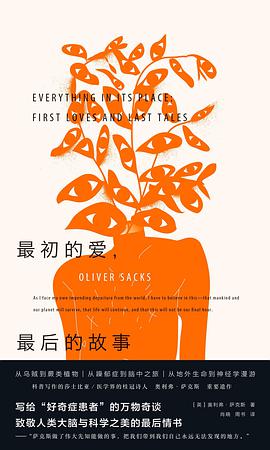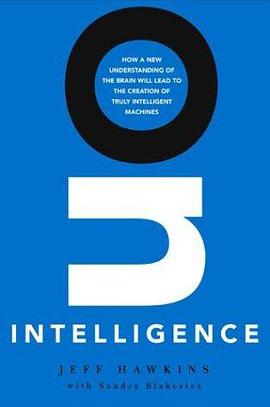最初的爱,最后的故事 豆瓣
Everything in Its Place: First Loves and Last Tales
7.8 (13 个评分)
作者:
[英] 奥利弗·萨克斯
译者:
肖晓
/
周书
广西师范大学出版社
2021
- 7
【编辑推荐】
♣ 医学界的桂冠诗人,科普写作的莎士比亚,奥利弗·萨克斯医生最后的遗作与漫长的告别:
广袤浪漫如宇宙或大脑,美丽幽深如记忆与神经,一部写给“好奇症患者”的万物奇谈,致敬人类大脑与科学之美的最后情书;
数十家欧美一线媒体重磅推荐,著名导演韦拉斯哈古的挚爱之书 。
♣ 介于文学与科学之间的书写,浪漫而严谨,温柔且坚定,萨克斯医生展现出他身兼科学家、说书人与诗人的神奇魅力:
作为脑科学界最受欢迎的畅销书作家,奥利弗·萨克斯的作品一直难以归类,本书则尤其丰富而复杂,闪耀着万花筒般的好奇之思。
它是萨克斯医生最后的声音,通过它,我们既可观望到他遥远的童年与原点,也可透过科学家的苍老之眼,凝视无限宇宙与有限肉身。
♣ 从乌贼到蕨类植物,从躁郁症到脑中之旅,从地外生命到神经学漫游,从“最初的爱”到“最后的故事”:
“最初的爱”是献给乌贼与其他头足纲动物的诗篇,饱含着少年趣味与科学浪漫,将读者带回“成为科学家”这一漫长旅程最初的起点;“最后的故事”则是对科学与人世的爱之告白,在饱含尊严的动人讲述中,向世界缓缓道别。
♣ 躁郁症、阿尔茨海默病、图雷特综合征、库鲁病……千奇百怪又触动人心的真实病例,集结作者临床生涯的精彩故事:
在局部麻醉状态下接受开颅手术中,会产生什么样的幻觉?我们的大脑原来是不会痛的?将一个人从僵死状态唤醒,竟会要了他的性命?车祸中的幸存者,为何反而深受自杀冲动的困扰?
每一个怪奇病例背后,都有着独特个体与艰难的灵魂。集诗人与医生于一身的萨克斯就如同《神曲》中的维吉尔,带领着读者在人类的认知与记忆,在大脑的沟回与起伏间浪漫游走。
♣ 复旦大学类脑智能博士生导师 × 神经科学主治医生,两位优秀科学青年联袂翻译,精准把握从理论到临床的专业知识背景;单向文学节年度设计奖得主、新锐设计师山川担纲装帧设计:
120*200细长开本,优美便携,趣味盎然。
————————
【内容简介】
“科学远不像许多人想象的那样冷淡和抽象,而是伴随着激情、渴望和浪漫。”
作为脑科学界最受欢迎的畅销书作家,奥利弗·萨克斯一直以其极富人文色彩的医学故事写作而享誉全球,他记录下病态背后的一系列奇异大脑与独立个体,被誉为“医学界的一千零一夜”。
但不同于过往作品,本书是萨克斯在临终前回望人生,写给青春与记忆、身体与疾病、大脑与科学的最后一封情书。他写到了自己从小对博物馆、图书馆的喜爱,对乌贼、蕨类植物的痴迷;同时以一贯细腻、精确和极富人文关怀的笔触,讲述了阿尔茨海默病、图雷特综合征、躁郁症等疾病的动人病例;并在大限将至之际,对纸书阅读、电子产品迷恋症、摄影技术乃至外星生命都做了精彩的思考。
他在博物、艺术、脑科学、神经医学、生物与化学、心智与认知等众多议题之间自如游弋,如同一个孩童在溪水间轻盈跳跃,将我们带回萨克斯医生“最初的爱”,回到科学的童心与原点。同时,它也召唤出萨克斯医生最后的声音,通过科学家的苍老之眼,重新观看我们身边的世界、广袤的宇宙与生命的迷人之处。可以说,这本书就是萨克斯医生最后的生命附言。
————————
【媒体推荐】
♠对我来说,这本书与电影紧密相关。它写到了大脑、认知和记忆。
——阿彼察邦·韦拉斯哈古(泰国著名导演)
♠生命从奥利弗·萨克斯的所有著作中喷涌而出。他曾经是、也将一直是一位杰出的奇人。在他的作品中,很难找到一个无聊的段落、一个沉闷的句子。
——《纽约时报书评》
♠在这部此前从未出版过的动人文集中,已故神经学家、知名作家奥利弗·萨克斯就他的医学生涯、青春岁月、心理健康领域等话题进行了思考……在探索艰深的主题时,萨克斯温柔、沉思的口吻是一剂良药,但书里也有不少轻松的时刻……对“慢性好奇症患者”来说,阅读这本最后的集子是种莫大的享受。
——《出版人周刊》
♠神经学家奥利弗·萨克斯的这部遗作进一步巩固了他在科学作家圣殿中的地位……他灵动的文字如显微镜一般——放大的镜头下是他个人生命中的细微场景,镜头后退又能将生活与科学囊括为一体。
——《科学家》杂志
♠充满魔法……这本书展现了神经学家萨克斯无穷无尽的好奇心。
——《人物》杂志
♠极其感人——书中不乏萨克斯一贯的能量和好奇,但也有他脆弱、敏感的一面……如萨克斯所言,他曾是个“满怀真与美”的普通男孩;随着时间的推移,我们越来越清楚地看到,萨克斯仍是那个始终如一的男孩,以永无止境的惊奇和急切,不仅与科学,还与科学史、塑造科学史的先辈进行互动……
我们不禁感到,面对未来,我们最好的机遇,就是人群中还有其他如萨克斯这般出类拔萃、充满激情、思想开明之人。
——《纽约书评》
♠如果你还不熟悉奥利弗·萨克斯,阅读这本书就是与他结识的绝佳方式……他是一位充满人文关怀的作者,拥有让人肃然起敬的力量,也能让读者睁眼见证地球上最微小、最被人遗忘的生命之美。
最重要的是,他能以高超的写作技艺让非专业领域的读者潜入神经科学之中。他满怀永不停歇的质疑和困惑书写着人类复杂的存在现状。他的写作文辞优美,发人深省。
——《纽约图书杂志》
♠萨克斯以这部最后的集子进一步巩固了自己的文字遗产……“科学写作的莎士比亚”这个称号也许名副其实,但萨克斯拒绝与过去时代或者当代的写作者相比较。值得读者欣慰的是,或许癌症能夺去他的肉身,他的声音将永远回响。“
——《科学家》杂志
♣ 医学界的桂冠诗人,科普写作的莎士比亚,奥利弗·萨克斯医生最后的遗作与漫长的告别:
广袤浪漫如宇宙或大脑,美丽幽深如记忆与神经,一部写给“好奇症患者”的万物奇谈,致敬人类大脑与科学之美的最后情书;
数十家欧美一线媒体重磅推荐,著名导演韦拉斯哈古的挚爱之书 。
♣ 介于文学与科学之间的书写,浪漫而严谨,温柔且坚定,萨克斯医生展现出他身兼科学家、说书人与诗人的神奇魅力:
作为脑科学界最受欢迎的畅销书作家,奥利弗·萨克斯的作品一直难以归类,本书则尤其丰富而复杂,闪耀着万花筒般的好奇之思。
它是萨克斯医生最后的声音,通过它,我们既可观望到他遥远的童年与原点,也可透过科学家的苍老之眼,凝视无限宇宙与有限肉身。
♣ 从乌贼到蕨类植物,从躁郁症到脑中之旅,从地外生命到神经学漫游,从“最初的爱”到“最后的故事”:
“最初的爱”是献给乌贼与其他头足纲动物的诗篇,饱含着少年趣味与科学浪漫,将读者带回“成为科学家”这一漫长旅程最初的起点;“最后的故事”则是对科学与人世的爱之告白,在饱含尊严的动人讲述中,向世界缓缓道别。
♣ 躁郁症、阿尔茨海默病、图雷特综合征、库鲁病……千奇百怪又触动人心的真实病例,集结作者临床生涯的精彩故事:
在局部麻醉状态下接受开颅手术中,会产生什么样的幻觉?我们的大脑原来是不会痛的?将一个人从僵死状态唤醒,竟会要了他的性命?车祸中的幸存者,为何反而深受自杀冲动的困扰?
每一个怪奇病例背后,都有着独特个体与艰难的灵魂。集诗人与医生于一身的萨克斯就如同《神曲》中的维吉尔,带领着读者在人类的认知与记忆,在大脑的沟回与起伏间浪漫游走。
♣ 复旦大学类脑智能博士生导师 × 神经科学主治医生,两位优秀科学青年联袂翻译,精准把握从理论到临床的专业知识背景;单向文学节年度设计奖得主、新锐设计师山川担纲装帧设计:
120*200细长开本,优美便携,趣味盎然。
————————
【内容简介】
“科学远不像许多人想象的那样冷淡和抽象,而是伴随着激情、渴望和浪漫。”
作为脑科学界最受欢迎的畅销书作家,奥利弗·萨克斯一直以其极富人文色彩的医学故事写作而享誉全球,他记录下病态背后的一系列奇异大脑与独立个体,被誉为“医学界的一千零一夜”。
但不同于过往作品,本书是萨克斯在临终前回望人生,写给青春与记忆、身体与疾病、大脑与科学的最后一封情书。他写到了自己从小对博物馆、图书馆的喜爱,对乌贼、蕨类植物的痴迷;同时以一贯细腻、精确和极富人文关怀的笔触,讲述了阿尔茨海默病、图雷特综合征、躁郁症等疾病的动人病例;并在大限将至之际,对纸书阅读、电子产品迷恋症、摄影技术乃至外星生命都做了精彩的思考。
他在博物、艺术、脑科学、神经医学、生物与化学、心智与认知等众多议题之间自如游弋,如同一个孩童在溪水间轻盈跳跃,将我们带回萨克斯医生“最初的爱”,回到科学的童心与原点。同时,它也召唤出萨克斯医生最后的声音,通过科学家的苍老之眼,重新观看我们身边的世界、广袤的宇宙与生命的迷人之处。可以说,这本书就是萨克斯医生最后的生命附言。
————————
【媒体推荐】
♠对我来说,这本书与电影紧密相关。它写到了大脑、认知和记忆。
——阿彼察邦·韦拉斯哈古(泰国著名导演)
♠生命从奥利弗·萨克斯的所有著作中喷涌而出。他曾经是、也将一直是一位杰出的奇人。在他的作品中,很难找到一个无聊的段落、一个沉闷的句子。
——《纽约时报书评》
♠在这部此前从未出版过的动人文集中,已故神经学家、知名作家奥利弗·萨克斯就他的医学生涯、青春岁月、心理健康领域等话题进行了思考……在探索艰深的主题时,萨克斯温柔、沉思的口吻是一剂良药,但书里也有不少轻松的时刻……对“慢性好奇症患者”来说,阅读这本最后的集子是种莫大的享受。
——《出版人周刊》
♠神经学家奥利弗·萨克斯的这部遗作进一步巩固了他在科学作家圣殿中的地位……他灵动的文字如显微镜一般——放大的镜头下是他个人生命中的细微场景,镜头后退又能将生活与科学囊括为一体。
——《科学家》杂志
♠充满魔法……这本书展现了神经学家萨克斯无穷无尽的好奇心。
——《人物》杂志
♠极其感人——书中不乏萨克斯一贯的能量和好奇,但也有他脆弱、敏感的一面……如萨克斯所言,他曾是个“满怀真与美”的普通男孩;随着时间的推移,我们越来越清楚地看到,萨克斯仍是那个始终如一的男孩,以永无止境的惊奇和急切,不仅与科学,还与科学史、塑造科学史的先辈进行互动……
我们不禁感到,面对未来,我们最好的机遇,就是人群中还有其他如萨克斯这般出类拔萃、充满激情、思想开明之人。
——《纽约书评》
♠如果你还不熟悉奥利弗·萨克斯,阅读这本书就是与他结识的绝佳方式……他是一位充满人文关怀的作者,拥有让人肃然起敬的力量,也能让读者睁眼见证地球上最微小、最被人遗忘的生命之美。
最重要的是,他能以高超的写作技艺让非专业领域的读者潜入神经科学之中。他满怀永不停歇的质疑和困惑书写着人类复杂的存在现状。他的写作文辞优美,发人深省。
——《纽约图书杂志》
♠萨克斯以这部最后的集子进一步巩固了自己的文字遗产……“科学写作的莎士比亚”这个称号也许名副其实,但萨克斯拒绝与过去时代或者当代的写作者相比较。值得读者欣慰的是,或许癌症能夺去他的肉身,他的声音将永远回响。“
——《科学家》杂志



